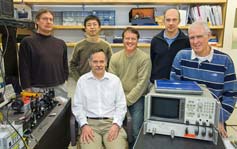
Handy Links
SLAC News Center
SLAC Today
- Subscribe
- Archives: Feb 2006-May 20, 2011
- Archives: May 23, 2011 and later
- Submit Feedback or Story Ideas
- About SLAC Today
SLAC News
Lab News
- Interactions
- Lightsources.org
- ILC NewsLine
- Int'l Science Grid This Week
- Fermilab Today
- Berkeley Lab News
- @brookhaven TODAY
- DOE Pulse
- CERN Courier
- DESY inForm
- US / LHC
SLAC Links
- Emergency
- Safety
- Policy Repository
- Site Entry Form

- Site Maps
- M & O Review
- Computing Status & Calendar
- SLAC Colloquium
- SLACspeak
- SLACspace
- SLAC Logo
- Café Menu
- Flea Market
- Web E-mail
- Marguerite Shuttle
- Discount Commuter Passes
-
Award Reporting Form
- SPIRES
- SciDoc
- Activity Groups
- Library
Stanford
Around the Bay
Timing the Science of the LCLS
 The Linac Coherent Light Source (LCLS) will be the world’s first free-electron laser to produce ultra-fast, hard X-rays. The machine's design calls for nearly two miles of
linear accelerator coupled to long arrays of undulator magnets to pull off this
achievement. But because of the length of the machine, the LCLS faced a unique new set of challenges in precisely synchronizing the components that must work together at different ends. SLAC turned to Lawrence Berkeley National Lab, which solved the problem with an innovative optical synchronization system.
The Linac Coherent Light Source (LCLS) will be the world’s first free-electron laser to produce ultra-fast, hard X-rays. The machine's design calls for nearly two miles of
linear accelerator coupled to long arrays of undulator magnets to pull off this
achievement. But because of the length of the machine, the LCLS faced a unique new set of challenges in precisely synchronizing the components that must work together at different ends. SLAC turned to Lawrence Berkeley National Lab, which solved the problem with an innovative optical synchronization system.
The collaboration, part of a long history of cooperation between SLAC and Berkeley Lab, is essential for the success of the LCLS, said Bill White, head of SLAC's Laser Group. "If we had started from ground zero and tried to develop this [system] in-house, we wouldn’t have been able to do it in time."
When complete, the LCLS will produce pulses of X-rays less than 100 femtoseconds long, or 100 quadrillionths of a second. Much as a strobe light can "freeze" the motion of a bullet in flight, and because the wavelength of the hard X-rays is so small, ultra-fast pulses from the LCLS will freeze the activities and motions of individual atoms. Images made this way can be strung together, allowing scientists to construct movies showing how the properties of matter evolve on atomic size and time scales.
But to achieve this, the timing of the system that creates the initial pulse at the beginning of the machine must be precisely synchronized with the experiment happening two miles away. If the two events aren’t locked in time, there would be no way to reconstruct the sequence of the data.
"Imagine if you have a movie and you scramble all the scenes. It wouldn’t make any sense," said White.
Although the speed of light is a constant, the time it takes the synchronizing signal to travel down two miles of cable is not. Even slight temperature changes in the room will alter the cable length by a few millimeters—enough to throw off the timing by 50 picoseconds, or 500 times greater than the system can tolerate.
"Existing timing systems cannot even come close to doing what’s needed for the LCLS," said John Byrd, Berkeley Lab's project director for the optical timing system.
Byrd's group designed a system that used light waves to continuously measure the length of the timing cable. By sending light of a constant frequency down the cable and reflecting it back on itself, the light waves produce interference fringes that the team can count, revealing even tiny changes in the cable’s length and allowing the team to correct the output signal.
In an initial month-long test of the prototype system performed at SLAC in December 2007, the system had a total drift of only 15 femtoseconds, far better than LCLS's minimum requirement. Further design improvements have resulted in a next-generation system that Berkeley Lab plans to test at SLAC in a few weeks. The final system will be delivered for the LCLS start-up in July 2009.
The project has been a huge benefit to Berkeley Lab as well, Byrd said. "What’s really exciting for us is to see this stuff in operation in a real machine. We can do all the tests we want up here in a building, but without really testing it on a machine like the LCLS that needs this level of synchronization, it's just academic."
—Madolyn Rogers, SLAC Today, April 14, 2008
The group at Berkeley Lab that developed the timing system for the LCLS. (From left: Russell Wilcox, Gang Huang, Larry Doolittle [seated], John Byrd, Alex Ratti and John Staples. Click image for larger version.)